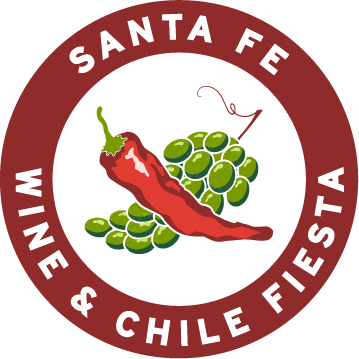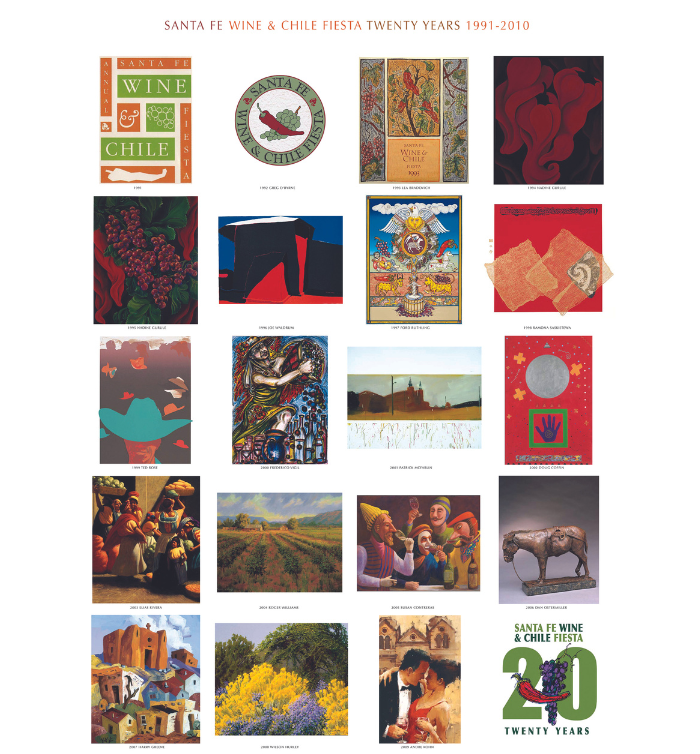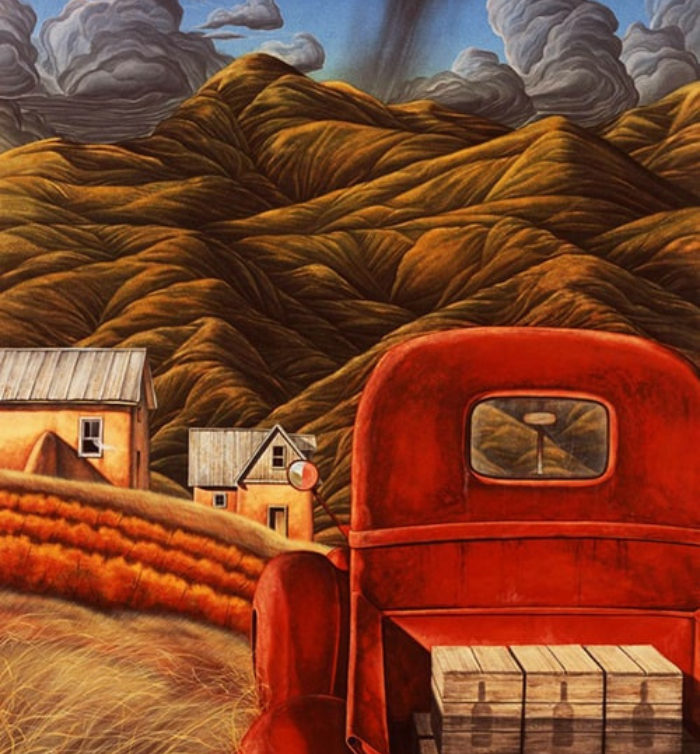1999 Ted Rose "Big Hats no Cattle"
1999 Ted Rose Poster & Signed Lithographs
Ted Rose (1940–2002) specialized in watercolors, in particular, watercolors centering around 20th-century American railroad art. (In 1999, the U.S. Postal Service selected him to paint five locomotives for the “All Aboard” stamp series, and Amtrak picked him as the artist for its 1997, 1998, and 1999 calendars.)
Although he painted plenty in his younger years and majored in art in college, financial necessity more or less forced him to give up painting until 1983. That year, he started painting again, and from then on produced over 1,000 works over the next 20 years, most of which centered on realistic depictions of trains and the railroad.
2003 Elias Rivera "SFWCF 2003"
2003 Elias Rivera Poster
Rivera was born in 1937 in New York City and in 1982, moved to Santa Fe, where he soon established himself as an internationally acclaimed painter. He attended the Art Students League (under the tutelage of Frank Mason), and painted somewhat disturbing canvases of New York’s raw street life.
In his paintings, Rivera explores the colorful costumes and street life of the native populations of Santa Fe, New Mexico; Guatemala, Mexico and Peru.
2013 William Haskell "Bound for Santa Fe"
2013 William Haskell Poster
Haskell, 44, lives in Galisteo, just south of Santa Fe, and often paints scenes of the surrounding landscape. Other favorite locations are north of Las Vegas, along the High Road to Taos, and in the small village of Rancho de Las Golondrinas. In his watercolors, real-life images often shape-shift.
Haskell’s biggest influence was another realist painter: Andrew Wyeth
Haskell began drawing at the early age of four, and was introduced to watercolor by the age of eleven. “Drawing,” he once said, “is the basis for my painting and it has been essential for me to continuously develop my drafting skills.”
Ask about our signed posters!
2016 Darren Vigil Gray "Earth Song"
2016 Darren Vigil Gray Poster
Vigil Gray, of Jicarilla and Apache/Kiowa Apache heritage in northern New Mexico, has been called the “Golden Boy of the third generation” of Native American painters. He began studying art in 1975 while enrolled in the high school program at Santa Fe’s Institute of American Indian Arts. He later studied at the College of Santa Fe and the University of New Mexico, but by 1986 had given up academics and was painting full-time.
Inspired by several artists over the years (most notably the great Kiowa/Caddo painter T. C. Cannon, Vigil Gray’s first mentor), since 1990, Vigil Gray’s work has reflected his admiration for Abstract Expressionists such as Willem de Kooning and Jackson Pollock, as well as members of the Bay Area Figurative movement—Elmer Bischoff, David Park, and Richard Diebenkorn.
As he has said of his painting technique: “I have to make a lot of chaos, and out of the chaos I start massaging the forms into play. It’s almost predestined, but I have to go through this process of chaos and find resolution to it.”
The canvases he’s become best known for are his “mythological” paintings, or “dreamscapes”—ambitious compositions of haunting characters created entirely out of his imagination and often draw from the area near his homeland near Abiquiu, New Mexico.
Ask about our signed posters!
2015 Dan Namingha "Desert Light"
2015 Dan Namingha Poster
Namingha, born in Keams Canyon, Arizona in 1950, is a painter and sculptor, and great-great-grandson of Nampeyo, the hugely influential Hopi-Tewa potter who lived on the Hopi Reservation in Arizona.
A longtime Santa Fean, Namingha studied at the Institute of American Indian Arts in Sante Fe, and at the American Academy of Art in Chicago, where he was influenced by the work of Jackson Pollack, Adolph Gottlieb, Michelangelo, Vincent Van Gogh, and Norman Rockwell.
Ask about our signed posters!
2014 Cody Brothers “Special Delivery on The Santa Fe Trail”
2014 Cody Brothers Poster
Cody Brothers “Special Delivery on The Santa Fe Trail” 25 x 36
Ask about our signed posters!
2017 Dick Evans "Dark Forms with Red Sky"
2017 Dick Evans Poster
Poster: Dark Form with Red Sky by Dick Evans, 2016, 30” x 30” oil, For SFWC
Born in the Land of Enchantment, Evans grew up in a rural farming community in the panhandle of Texas, where he had no exposure at all to art until he started college. While in college, though, he was required to take drawing and design courses (as part of his curriculum as an architecture major). He soon realized architecture was not right for him but art was.
He then switched to an advertising art program at Texas Tech, where he then realized he was more interested in Fine Arts. So he then transferred again—to the art program at the University of Utah, where he obtained a BFA in Drawing and Painting and went on to obtain an MFA in Ceramics and Sculpture.
After college, he began a university teaching career, being granted tenure at just 29. Uneasy about settling into one area so early in life he resigned within the month and set out on his own with his wife and two children, establishing studios in Northern New Mexico in which he produced sculpture and ceramics.
After a year he realized how much he missed teaching and returned to the university scene. He spent a year teaching at the University of Tennessee-Knoxville. Then he spent three years teaching art at the University of New Mexico. In 1975 he married for the second time. This time to sculptor Susan Stamm Evans, with whom he is still married. Then in 1975 he took a position teaching art at the University of Wisconsin-Milwaukee. Evans progressed through the professorial ranks to tenure, full professorship and also a two-year stint as Associate Dean of the School of Fine Arts.
In 1987 the Evans’ decided to leave academia and devote themselves full-time to their art. In 1990 they returned to New Mexico, moving to Santa Fe, where they built a house with two studios.
Ask about our signed posters!










